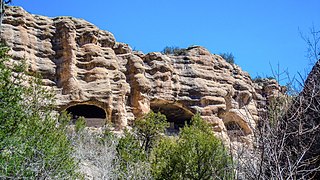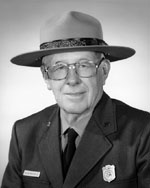
Bryce Canyon National Park is an American national park located in southwestern Utah. The major feature of the park is Bryce Canyon, which despite its name, is not a canyon, but a collection of giant natural amphitheaters along the eastern side of the Paunsaugunt Plateau. Bryce is distinctive due to geological structures called hoodoos, formed by frost weathering and stream erosion of the river and lake bed sedimentary rocks. The red, orange, and white colors of the rocks provide spectacular views for park visitors. Bryce Canyon National Park is much smaller and sits at a much higher elevation than nearby Zion National Park. The rim at Bryce varies from 8,000 to 9,000 feet.

The National Park Service (NPS) is an agency of the United States government that manages all national parks, most national monuments, and other natural, historical, and recreational properties with various title designations. The United States Congress created the agency on August 25, 1916 through the National Park Service Organic Act.

Petroglyph National Monument stretches 17 miles (27 km) along Albuquerque, New Mexico's West Mesa, a volcanic basalt escarpment that dominates the city's western horizon. Authorized June 27, 1990, the 7,236 acre (29.28 km2) monument is cooperatively managed by the National Park Service and the City of Albuquerque. The western boundary of the monument features a chain of dormant fissure volcanoes. Beginning in the northwest corner, Butte volcano is followed to its south by Bond, Vulcan, Black and JA volcanoes.

Gila Cliff Dwellings National Monument is a U.S. National Monument created to protect Mogollon cliff dwellings in the Gila Wilderness on the headwaters of the Gila River in southwest New Mexico. The 533-acre (2.16 km2) national monument was established by President Theodore Roosevelt through executive proclamation on November 16, 1907. It is located in the extreme southern portion of Catron County. Visitors can access the monument by traveling northbound from Silver City, New Mexico, 45 miles (72 km) on NM 15.

Frances P. Mainella was the 16th Director of the National Park Service of the United States and first woman to hold that position. She was appointed by President George W. Bush and confirmed by the U.S. Senate in 2001. She announced her retirement in July 2006 and resigned effective October 15, 2006. Mary A. Bomar, was sworn-in as the 17th Director on October 17, 2006. Mainella was in charge of the NPS when it allowed Redskin's Owner Dan Snyder to illegally remove 130 trees from his property, and while the park ranger who blew the whistle on this activity, Ranger Robert M. Danno, was persecuted at length. She subsequently gave contradictory accounts of this to federal investigators.

Grand Canyon–Parashant National Monument is located on the northern edge of the Grand Canyon in northwest Arizona. The monument was established by Presidential Proclamation 7265 on January 11, 2000.

Carl Parcher Russell was a historian, ecologist, and administrator.

George Alexander Grant was an American photographer who served as the first Chief Photographer for the U.S. National Park Service (NPS).

George B. Hartzog Jr. was an American attorney and Director of the National Park Service. Admitted to the bar in South Carolina in 1942, he became an attorney for the General Land Office in the Department of the Interior in 1945, and six months later transferred to the National Park Service.

Zion National Park is an American national park located in southwestern Utah near the town of Springdale. A prominent feature of the 229-square-mile (590 km2) park is Zion Canyon, which is 15 miles (24 km) long and up to 2,640 ft (800 m) deep. The canyon walls are reddish and tan-colored Navajo Sandstone eroded by the North Fork of the Virgin River. The lowest point in the park is 3,666 ft (1,117 m) at Coalpits Wash and the highest peak is 8,726 ft (2,660 m) at Horse Ranch Mountain. Located at the junction of the Colorado Plateau, Great Basin, and Mojave Desert regions, the park has a unique geography and a variety of life zones that allow for unusual plant and animal diversity. Numerous plant species as well as 289 species of birds, 75 mammals, and 32 reptiles inhabit the park's four life zones: desert, riparian, woodland, and coniferous forest. Zion National Park includes mountains, canyons, buttes, mesas, monoliths, rivers, slot canyons, and natural arches.

Robert G. "Bob" Stanton is a retired career civil service administrator who served for almost four decades in the United States National Park Service. He was the first African American to be appointed as the Director of the Park Service, serving 1997–2001.

William Penn Mott Jr., earned bachelor and master degrees from Michigan State University and University of California, respectively. After graduation, he worked for the San Francisco office of the National Park Service (NPS) as a landscape architect from 1933 to 1940. He then became director of the Oakland, California Zoo. In 1962, he was hired as director of the East Bay Regional Park District until 1967. California Governor Ronald Reagan named Mott as the Director of the California Park Service in 1967, where he remained until 1985, when President Reagan named him to head the U.S. National Park Service (NPS). Mott served at the Federal level until President George W. Bush nominated a replacement for him in 1987. He continued to work for the NPS as a consultant until his death in 1992. His last major project was to transition the Presidio in San Francisco into a national park.

Ronald H. Walker is an American executive. Walker served in the administration of President Richard Nixon, first as the first Director of the White House Office of Presidential Advance, and later as Director of the National Park Service (1972–1975). Walker went on to become a senior partner at Korn/Ferry International, President of the Richard Nixon Foundation, and is currently the Chairman of the Board of the Nixon Foundation.

The National Park Service (NPS) in the United States is a Bureau of the Department of the Interior with its headquarters located in Washington, D.C. The bureaus consist of numerous support offices and seven regional offices, which oversee park operations within their geographic area. The NPS has 3 main offices/verticals that support the Office of the Director: The Office of Congressional & External Relations, The Office of Management & Administration, and Operations.

Shelton Johnson is a park ranger with the U.S. National Park Service, and works in Yosemite National Park. As of 2021 he had worked in Yosemite for 28 years of his 35-year career.
Robert O. Binnewies is an American conservationist. Graduate, Colorado State University, 1959, bachelor of science degree, forest recreation. Joined National Park Service, 1961, as a park ranger, Yellowstone National Park, Wyoming. Subsequent NPS assignments included Washington, D.C., 1964–1966, chief ranger, Acadia National Park, Maine, 1967–1971, and superintendent, Yosemite National Park, California, 1979–1986.
Architects of the National Park Service are the architects and landscape architects who were employed by the National Park Service (NPS) starting in 1918 to design buildings, structures, roads, trails and other features in the United States National Parks. Many of their works are listed on the National Register of Historic Places, and a number have also been designated as National Historic Landmarks.
Denis P. "Deny" Galvin is a career government administrator, who served as Deputy Director, and as Acting Director, of the U.S. National Park Service.
Throughout the first century of the United States National Park Service (NPS), the organization's workforce has grown more inclusive and gender-balanced. When the organization was formed in 1916, few female rangers worked within its ranks. As the organization grew, more women were hired into white-collar and clerical positions. As social activism and second-wave feminism movements gained ground in the 1960s and 70s, women were hired into more diverse occupations and leadership roles within the NPS. Today, the National Park Service still faces a gender disparity with 37% of the workforce being female and has been criticized for its response to several sexual harassment cases.

Cassius Cash is currently serving as the 16th superintendent of Great Smoky Mountains National Park encompassing the eponymous mountain range in East Tennessee and Western North Carolina.
















